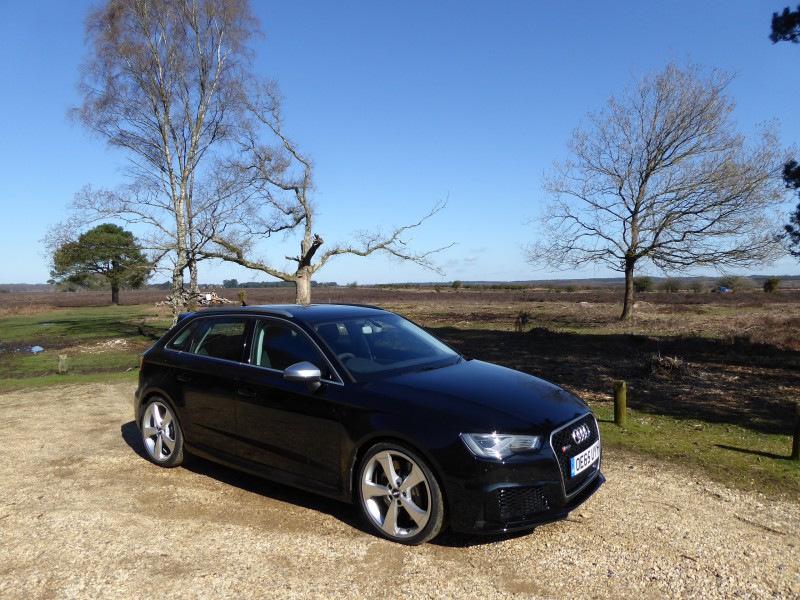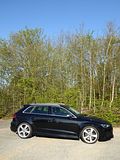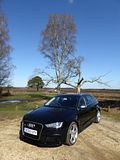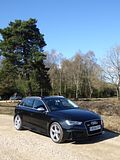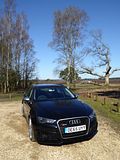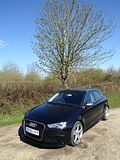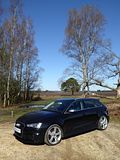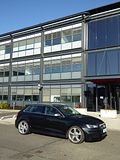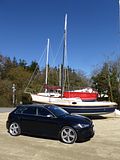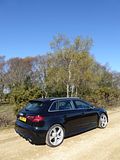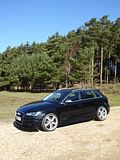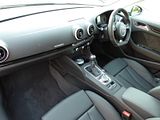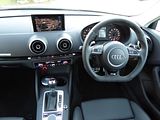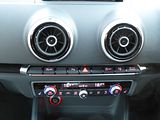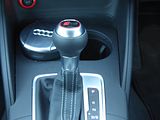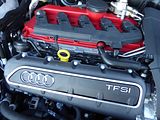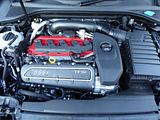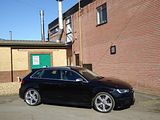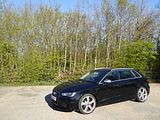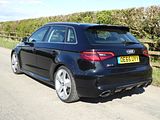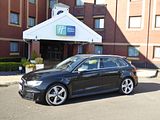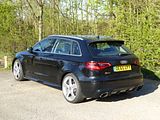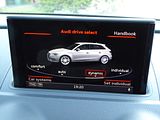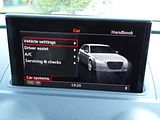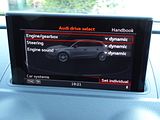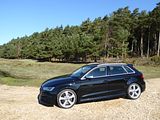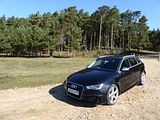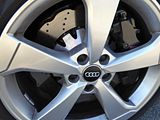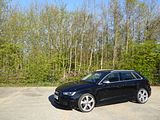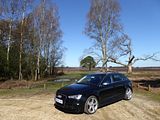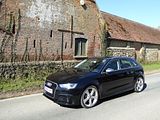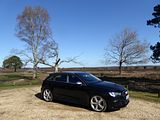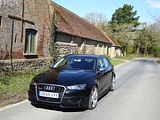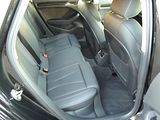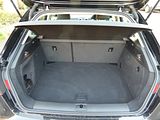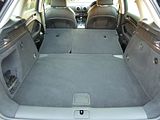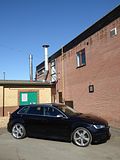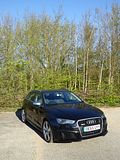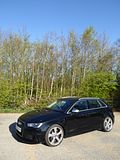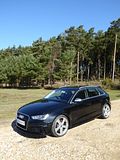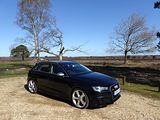
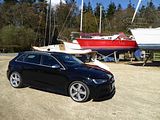
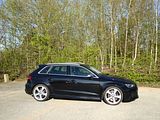
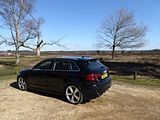

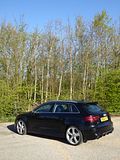
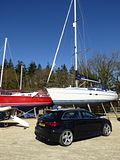
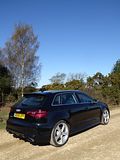

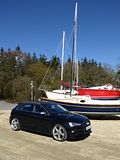
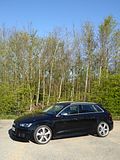
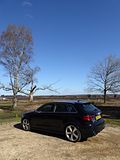


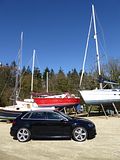
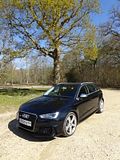

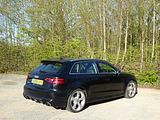
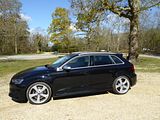
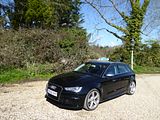
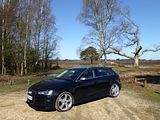
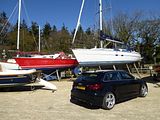
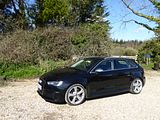
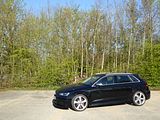
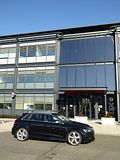
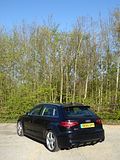

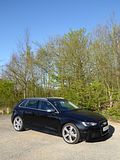
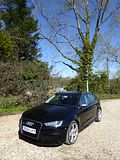
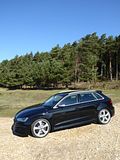
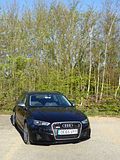
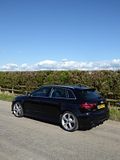
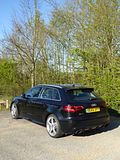
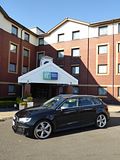
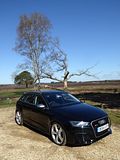
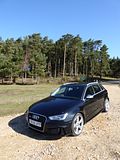
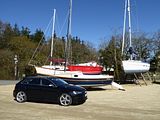
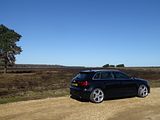
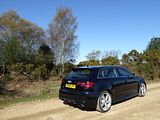
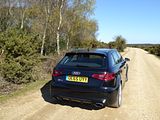
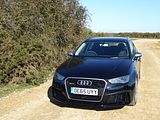
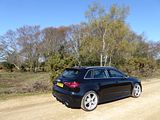
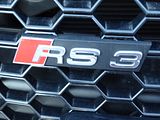
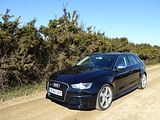
The subtle look continues inside. Open the door, and you will spot the RS3 logo on the kick plates, and the seats are not quite your standard A3-style chairs, though they are less extreme than you might be expecting. Other than that, you might spot the “quattro” badge on the dash in front of the passenger and the RS3 gearknob, but you will have to look harder to see anything else to identify this range-topper. There is an RS3 logo across the top of the instrument display when it lights up, and if you look at the dials, you will spot that where lesser A3 models have a water temperature gauge, here there is a turbo boost gauge, and there is a button marked “Drive Select” which hints at what could be in store. Ah, and there is and of course an RS3 steering wheel. Flat bottomed, it has a smaller diameter than the regular cars, and it is trimmed in a mix of nappa leather and alcantara, which makes it particularly agreeable to hold. There are alcantara inserts on the door casings, along with a thin sliver of gloss black but in the black interior trim of the test car, these features may not get spotted at that initial glance. Not that being similar to a standard A3 is a bad thing, as that means you get what is almost certainly the highest quality interior of any car in the class. Fit and finish are impeccable, and there are lots of high quality plastics that are soft to the touch. Audi took the step of simplifying the number of buttons and switches with this generation A3, and visually they have certainly succeeded. There is a cowled binnacle which covers the instruments, of which there are just two: a rev counter and a speedometer, both with crystal clear markings which look almost three-dimensional from some angles. Inset in the lower right quadrant of each is a bar chart type display for turbo boost and fuel level. Between the dials is a digital display area which shows everything from selected radio station to a set of data points which you select by using the switches on the left spoke of the steering wheel, and the odometer, outside temperature and a digital clock. The selectable bit can show your current speed, or trip computer functions such as current or average fuel consumption, average speed, journey time and distance. Selecting between these uses the thumb wheel on the left spoke of the wheel, and there is a toggle switch above it to choose other functions that can be displayed, and to change the radio channel selected. It is not quite as simple to operate in previous Audis where the radio channel was done using the thumb wheel and everything else was done by a button on the end of the right hand column stalk, but I quickly adjusted to it. The column stalks are stock VAG Group items, with indicators on the left and wipers on the right. The optional cruise control operates from a shorter stalk, lower on the left of the wheel. Lights are controlled by a rotary dial on the right of the dash. The centre of the dash is where the real clean up has taken place. When the engine is off, the display screen is hidden in the dash. It powers up when you turn the ignition on, and there is a separate button to allow you manually to control it as well. That button is in one of those in a single row across the middle of the dash which also include the parking sensors, stop/start and the Drive Select more which we will come to. Beneath it are a single row of knobs and buttons for the dual zone climate control system. The MMI system, displayed on that colour screen, is operated using the rotary dial and a couple of toggle switches in the centre console. And that is it. Compare this with the button-fest that you get in so many cars and you will doubtless appreciate not just the visual simplicity of what Audi has done here.
However, no-one is going to select an RS3 because it has a nice interior. They are going to want one because of the way it drives, and it is here where it must impress. It was pouring with rain when the car I arrived, so we took it into the underground car park to do the handover, and that gave me the chance to hear the sound you get when you fire the engine in a confined space where it could resonate around. But even outdoors, the noise you get when you turn the key for the first, and every subsequent time will probably win you over, even without moving the car. Truly this is a great sounding engine, and that aural delight continues when underway. Pleasingly, the car is nice and refined when cruising at a steady speed on the motorway, so undertaking long journeys would be no hardship at all. Indeed, the first 110 miles I drove the car were in pouring rain in Friday afternoon traffic down the M4, when I was tired, and it was absolutely fine as a comfortable means of getting home without feeling any more frazzled. But when the mood takes you, there is an animal under the bonnet. Or more accurately, 362 horses. That is a lot for a car of this size, and the quoted acceleration time for 0 – 60 of just 4.1 seconds gives you the indication that this is a very rapid car indeed. And it certainly feels it. No matter what speed you are doing, if you push your foot a little harder on the throttle, the Audi rockets forward. There is instant acceleration available from any speed to any other. Care is needed, of course, as it is very easy to find yourself doing the sort of speeds that would land you in very deep trouble indeed. Whilst the engine is civilised when cruising, you will have lots of aural enjoyment when accelerating, even at quite modest rates. Five cylinder engines have a characteristic sound to them, and this one is among the best I have ever come across. There’s a Stop/Start system fitted, and as well as saving the odd carbon and drop of petrol, it has the added advantage that you get to hear the engine fire again, and again. Playing with the car proved that it is not hard to get the exhaust to pop as well, so you really can find all sorts of addictive sounds as well as that explosive acceleration to entertain yourself whenever the mood takes you. I am sure that if you over-indulge you will pay the price at the petrol pump, but I was pleasantly surprised to find that the average obtained on the motorway journey, at motorway speeds (!) as well as the cross-country test route both came in at at around 34 mpg, which is impressive considering the performance.
When I first got in the RS3, and manoeuvered it around the site, the steering seemed rather vague and feel-less, and I feared that all those UK motoring press castigations about Audi steering may have some validity. That meant it was time to look at the various Drive Settings that are available. The car as delivered was in Comfort mode. Changing this to Dynamic made a world of difference, adding weight and feel to the steering, making it pretty much what I would want and expect from a car like this. There is also an Individual model, which allows you to mix and match settings for the steering, suspension and throttle response. In some cars, changing these settings makes little discernible difference, but in this one, it most certainly did. Similarly, there was a big difference in the feel of the car if you set the transmission to Sport rather than Drive, with the car feeling even more eager, and it holding onto the gears for longer. It feels like it is straining at the leash in Drive, and it definitely is in Sport! The 7 speed DSG box is extremely smooth in operation, with only a change in engine note and the indicated revs really telling you that you are in a different gear. You can see which one you are in as it is shown in the very lower left of the digital display panel in the instrument cluster. There are paddles, with left to go down and right to go up a gear. Once set up, the RS3 behaved like I would have expected and wanted it to. It steers well, and thanks to the Quattro all wheel drive has prodigious amounts of grip. It goes round corners as if on the proverbial rails. You would have to be doing something extraordinarily silly to get anywhere close to the limits with this car on a public road. So, yes, on a track, it may lack the ultimate that makes the likes of Autocar magazine’s single-minded testers decide that they like the car, but for those of us who drive on public roads, there is nothing to dislike and everything to relish. You can specify, for more money, dynamic dampers, which the professionals claim are “essential” for the ride. I disagree. They were not on the test car, and not just I, but also my passenger for some part of the test, thought the ride to be absolutely fine as it is, and that included driving the car on a variety of surfaces, not all of them particularly smooth. There is some road noise on some surfaces, whereas on others, it is completely suppressed. Audi fit massive brakes to the RS3, with an unusual wavy design being adopted which they say is more effective. Although I had no occasion to perform an emergency stop, they gave every confidence that they would do the job. Certainly in normal motoring they worked well, with a nice progressive feel to the pedal. There is an electronic handbrake, with the button in the centre console, behind and to the right of the gearlever. Visibility is generally good, and with quite an upright rear end, judging the back of the RS3 is easy, but there are parking sensors to help and indeed these worked all round, with an infographic on the MMI screen, suggesting when you were getting close to trouble. There was no actual camera to show you just how close, though.
I was a little surprised to discover that seat adjustment was manual, as this is a £40k car, but you have to remember that it is really a £25 – 30k car with all the extra cost going into the engine, suspension and drivetrain upgrades. There was an electric lumbar adjuster, but this is a cost option that was fitted to the test car. The seats, complete with an RS3 logo in them, are high-backed items, and not as wrap around as you get in an RS4, but they did prove comfortable. Even on the lowest setting, they were perhaps a tad higher than I would have chosen, but the combination of the adjustments available and the telescoping wheel meant that I could easily get a good driving position.
Space in the rear is decent for this class of car, and certainly beats that of the 1 Series BMW by a long way. Leg room is good unless the front seat is well back, and there is plenty of head room. Three adults could sit across the width of this Audi, though it would be more comfortable for just two adults. There is no central armrest, but there are rear air vents. Occupants here get nets in the back of the front seats and pockets on the doors. The boot is probably quite a decent size for a car of this class, but it struck me when transferring stuff from my S5 Sportback just how much smaller it is, with the weekly bag and my lap top back more or less covering the floor area. It is extensible by dropping the asymmetrically split rear seat cushions forward, creating a long though not quite flat load space. There is not much room for anything under the boot floor, as this space is taken up by the battery and a huge sub-woofer. Inside the cabin, the glovebox is not very generous either, as most of it had been taken up by the upgraded Audio system. There are bins on the doors and a cubby under the central armrest, as well as bit of space in front of the cup holders which are in front of the gearlever.
Unlike the regular A3 models where there are a number of different trim levels available, for the RS3, there is no choice, just the single model. With the extra cost of an RS3 over an A3 being associated with the uprated mechanicals, the equipment levels cover the essentials but are far from lavish. Included as standard are an alarm (necessary, as RS3s are sadly something of a target for the criminal fraternity), alloy wheels, front fog lights, headlights washers, dual zone climate control, heated electrically adjustable mirrors, heated sports-style leather seats with a height adjuster for the driver, parking sensors, a decent audio system with CD slot, AUX, MP3 and Bluetooth as well as steering wheel mounted controls, as well as all the RS3 specific badging and trim. You can spend a lot of money on options for your RS3, as is the case with all premium German brands. Audi had resisted the urge with the test car, and the helpful info sheet supplied in the car advised me that the only cost items added to it were: metallic paint; aluminium roof rails; an upgraded Audi Sound System with 10 speakers; cruise control; electric lumbar support; and the Technology Pack which gives navigation. Those items increased the list price of the car from £39,620 to £42,485.
Be in no doubt, I loved the RS3. When I booked it, I did so because it was a rare opportunity to get to try one for a weekend, but it was not that serious a prospect to replace my much loved S5 Sportback. Having driven it for over 400 miles, on a mix of roads and traffic conditions, it proved to me that this is a perfectly civilised hatchback when you need it to be, but the Jekyll and Hyde character is there, so when you want some real fun, it is there for the taking. It won’t appeal to everyone, for sure. Some will complain that it looks too subtle, even after you have raided the options list. If a Mercedes-AMG A45 is your epitome of desirable, then clearly the brash and blinged up look that Audi so emphatically eschew will mean that you probably would not give the Ingolstadt product a second thought. But frankly you should. And if for no other reason than that engine. It is one of the most addictive power units I have ever come across. Choosing my new car suddenly got a whole lot harder.

